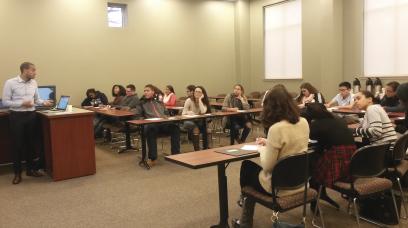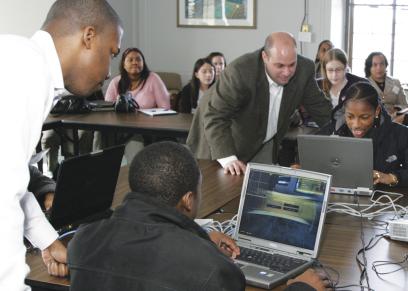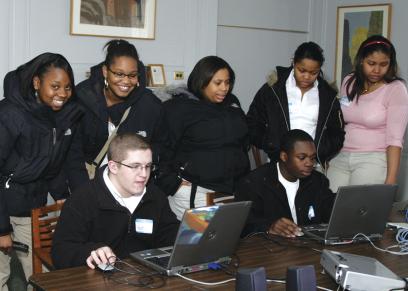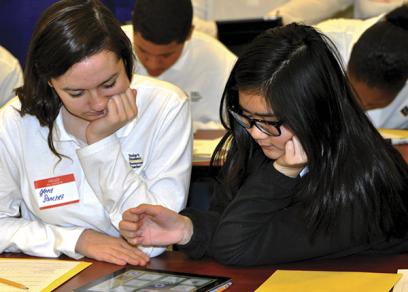In a country with an increasing population of nonwhite students, there are far too few teachers of color. The numbers are particularly distressing when it comes to finding male teachers of color, who are essential role models for black boys. As a result, black and Latino children sitting in classrooms with white teachers, day after day and year after year, can't help but get the message: teaching, and the educational attainment and authority it reflects, is not for people like them.
More than 20 years ago, the lack of diversity in the teaching force prompted me to start Today's Students Tomorrow's Teachers (TSTT), an organization that taps diverse and economically challenged students to consider teaching as a profession.
To find future teachers of color, TSTT relies on teachers and guidance counselors who know their students best and, as a result, are TSTT's primary recruiters. Our program then helps to nurture and mentor these students every step of the way, from high school through college. There are no shortcuts; this work requires extensive amounts of time and effort. But the payoff is great.
TSTT currently enrolls nearly 300 high school students who come from more than 45 high schools in Connecticut, Massachusetts, New York, and Virginia. The program also enrolls more than 300 college students who attend 21 partner institutions.
Our students are ethnically and socioeconomically diverse: approximately 47 percent are African American, 35 percent are Hispanic or Latino, 13 percent are white, and 3 percent are Asian/Pacific Islander. Twenty-three percent are male, and 75 percent are the first in their families to attend college. Since its inception, TSTT has succeeded in placing more than 150 men and women of color in classrooms across the country.
Humble Beginnings
I never imagined I would develop a program that would have such a profound impact on children of color, children like me and my brothers and sisters.
I grew up in acute poverty in the small, segregated town of Gadsden, South Carolina. My father died when I was 5, leaving my mother to raise six children alone. My mom worked tirelessly as a housecleaner and a nanny, the few occupations available to her. She even pressed soldiers' uniforms at a nearby army base.
Since my mother worked long hours, we children spent a lot of extra time at school, where teachers looked after us. One teacher, Mrs. Anderson, took me under her wing. She encouraged me to join the Future Educators of America club. Thanks to her, I found my calling. The desire to be a teacher, along with her encouragement, motivated me to graduate from high school and college.
After I earned my teaching certification in 1970, I felt I was on my way. I was keenly aware that I had far surpassed my parents' educational level, since I was the first in my family to graduate from college.
I took a job teaching middle school, about an hour from where I grew up. Life was quiet but good. While grading papers one Sunday afternoon, I was listening to the radio. James Clyburn, then the state's human affairs commissioner and now a Democratic congressman from South Carolina, came on the air. He talked about how IBM was looking for qualified applicants. I had never heard of IBM, but I was intrigued by Clyburn's message; he urged young black men and women to seek opportunities that he and others were working hard to make possible.
Soon after that radio address, I called IBM and landed an interview. I was offered a job on the spot—as a secretary. I quickly turned that down, seeing it as a step below teaching. But a few days later IBM called me back. Would I consider another position? One where I would work with customers along with the sales and marketing staff? That sounded interesting. I was young, curious, and thought I had nothing to lose. I signed on in 1975 in Columbia, South Carolina, 20 miles from Gadsden.
Ultimately, James Clyburn changed the trajectory of my life. Even though my new path led me away from education, the attention I had received from my teachers prepared me for other job opportunities.
IBM was fascinating. While working in Columbia, and in Atlanta, Georgia, I held jobs in marketing, management, and personnel. I also worked as a systems analyst. After numerous promotions, I was eventually transferred to the national headquarters in Armonk, New York—a long way from my hometown.
In Armonk, I was asked to lead a management and executive training program where I designed courses taken by more than 60,000 managers and other leaders, including school superintendents. I was teaching again! I remembered the sense of fulfillment I had felt as an English teacher so many years ago.
At this point (1993), I had spent nearly 20 years at IBM. I realized I was restless and ready for a new purpose. After meeting the superintendents in the training program, I thought, "I could do that!" By becoming a superintendent, I could unite my early training and love of education with my management experience. The first step would be to obtain a principal's license. So I enrolled in a program at Pace University.
One of my professors at Pace introduced me to Robert Roelle, the superintendent in Ossining, New York, a small community in Westchester County. He invited me to complete my required internship in his district, where the enrollment was about 23 percent black at the time yet the faculty included very few black teachers. He asked me to focus on minority teacher recruitment.
During my internship, I researched the issue and came up with a few short- and long-term strategies, including starting a future teachers club, so the district could "grow its own" minority teachers. After hearing this idea, Roelle asked me to make a presentation to neighboring superintendents. They were intrigued.
Shortly after my presentation, I left IBM and worked as a consultant to start future teachers clubs in two high schools in northern Westchester. I recruited students of color and gave them experience tutoring other children, with their own classroom teachers as mentors. I soon saw that the students I recruited felt isolated, so I began to bring together students from different high schools across Westchester under the banner Today's Students Tomorrow's Teachers.
After I earned my master's degree in educational administration and supervision at Pace, I enrolled at Fordham University, still on a path to becoming a superintendent. The chair of the graduate school and my dissertation mentor, Barbara Jackson, suggested I document the work I was doing with minority students for my doctoral dissertation, which I completed at Fordham in 2003.
I continued to focus on the design, development, and implementation of TSTT. I kept recruiting high school students from racially and culturally diverse and economically disadvantaged families. I gave students individual attention, found them teacher mentors, and arranged internships where they could work with younger children. I took them on college visits and helped them with their college applications. I watched my first cohort of high school graduates go off to college, with a sigh of relief and a swell of pride.
However, I quickly realized they would need continued mentoring and financial support to succeed in college. I knew that I needed to find a way to see them through. Armed with a little marketing experience, I began to call on college presidents in the area to support these students. I asked them to give a minimum 50 percent tuition scholarship to qualified TSTT high school graduates who met admissions standards. Miraculously, they agreed.
The scholarships were a big incentive. I then formalized what high school students would need to do to qualify, which included working as a teacher back in a TSTT school for at least one year after becoming certified.
During TSTT's first years, I had worked with high school juniors and seniors. But I realized I needed more time to recruit, mentor, and train students to ensure their academic success, so I decided to enroll students as early as ninth grade. I wanted students to have more time to see if teaching was a good fit. The earlier start also enabled me to help students prepare for college.
To me, teaching is a calling. Especially in some urban districts or isolated rural areas, it's imperative that teachers be caring, committed, and competent. If I could light a spark in high school and nurture that flame through college, I knew I could produce excellent, dedicated teachers who would stick with the profession. And even if not all our recruits became teachers, the attention and mentoring we provided would help them reap benefits no matter what path they pursued.
I watched and learned, and strengthened the program. Eventually, TSTT became my doctoral thesis. As part of my dissertation, I researched nearly 245 future teacher programs across the country and discovered that none continued to provide the necessary financial and emotional support students so desperately needed to complete college. In writing my dissertation, I realized I had created a new model. In 1999, I incorporated TSTT as a nonprofit organization.
My background at IBM provided me with the skills to approach businesses and banks to fund TSTT. I explained that an educated workforce would benefit the community and increase workplace diversity. I also explained the enormous power of a great teacher and the need for more effective teachers and role models who could help students reach their potential.
I acknowledged that not all TSTT graduates would become teachers, and that some would change course and enter careers in business, finance, law, or other professions. I said that if corporations wanted capable, prepared workers for the future, then they should not only invest in teachers to inspire and train the next generation, but also financially support students of color who had demonstrated the potential to graduate from college and become productive citizens.
Businesses and foundations responded favorably. Many gave me the funding to strengthen the program and support students through college.
The program first expanded throughout the Greater Hudson Valley region in New York state. Then JPMorgan Chase, an early supporter, approached us about replicating it elsewhere.
TSTT works thanks to regional advisory councils, led by a regional coordinator. The council includes representatives from each TSTT participating school district—preferably superintendents, a representative from area college partners, TSTT representatives (including the executive director), and business and/or community representatives. Each district has a mentor who serves on the advisory council, acts as a liaison to TSTT on program policies and procedures, and assists with recruitment of teacher mentors and hiring of TSTT teachers. Regional program managers, coordinators, and team leaders also implement the model in each area, while our headquarters in White Plains, New York, provides oversight.
The districts we partner with vary in size and location. For instance, Ossining, our first TSTT partner, is a small district with fewer than 5,000 students. Another of our partners, Prince William County Public Schools in Northern Virginia, has 87,000 students and 12 high schools.
When school officials in Prince William were looking to hire minority teachers, they invited me to speak with their school board. That was nine years ago. TSTT is now part of the district's "Growing Our Own" initiative designed to hire former students. The district plans to hire 1,000 teachers this school year, and it will rely on TSTT for qualified candidates of color who will help the district achieve its goal of diversifying the teaching staff.
In addition to growing geographically, TSTT has launched a male teacher of color initiative to help fill the shortage of African American and Latino male teachers. Sadly, African American male teachers account for only 2 percent of today's educator workforce.1
Two years ago, we also launched a middle school program in Westchester called the Student Leadership Movement (SLM) to recruit potential teachers earlier. SLM links middle school students with TSTT high school students who act as tutors and mentors as well as encourage them to consider becoming teachers.
A New and Comprehensive Model
TSTT provides a comprehensive, eight-year-plus teacher preparation program designed to recruit, mentor, and train low-income, ethnically diverse students from high school through college, and place them in teaching jobs in their communities. Because of its ability to not only recruit but retain teachers of color, the program is one of eight focused on increasing diversity that are highlighted in "The State of Teacher Diversity in American Education," a report published by the Albert Shanker Institute. (For more on the report, see "A Look at Teacher Diversity.")
After 20 years, the program has enabled me to meet hundreds of kindred souls who share the passion and purpose of helping our next generation to succeed. Ray Sanchez now serves as the superintendent in Ossining, where the first TSTT program began. Last year, when we honored the district at our 20th-anniversary breakfast, he said, "I'm a believer. TSTT is an investment in the future."
Today, just like in 1995, the district is still very concerned about diversifying its teaching staff. Over the years, the district has hired 14 former students of color, six of whom were recruited and mentored by me. I'm proud to say they have been teaching for more than 10 years.
To remain eligible for participation in the TSTT program, students must maintain a B+ average by the end of their senior year of high school, engage in job shadowing and summer internships, tutor two hours each week during the school year, attend regional TSTT workshops, and commit to teach in a participating school district for one year after receiving teaching credentials.
Participants meet weekly with peers, a TSTT program manager, and a teacher mentor. They engage in character development activities, as well as goal-setting and service learning opportunities. Students learn study and time-management skills, and they participate in team-building activities.
Students also plan for college and visit campuses. They receive admissions guidance and SAT preparation training. And because this program is geared toward preparing future teachers, students learn about what teaching entails. They study lesson planning and curriculum mapping, media and technology in education, conflict resolution strategies, and diversity issues in the classroom.
Once in college, students are assigned a mentor, usually an administrator or a professor. They return to their home districts for check-ins, mock interviews, resumé guidance, portfolio presentations, and professional etiquette workshops. TSTT also helps place college students in teaching-related summer internships.
By the time TSTT students earn their teaching certifications, they are ready to work, and TSTT helps them land a job, often at one of our more than 50 partner schools. TSTT graduates proudly tell me they are often better prepared for college and teaching careers than their classmates. And superintendents tell me that if they see an applicant is a TSTT graduate, they are confident in hiring that individual.
Currently, school districts pay a per-student fee of $3,000 to join the program. Each district agrees to identify ninth-graders who have the academic and leadership skills to succeed as teachers, along with a willingness to explore the teaching profession.
The mentor-mentee relationship is one of the program's strengths. We pay our mentors, who follow our curriculum. Over the years, many mentors and students have become friends, colleagues, and part of a strong support network that lasts long after the formal program ends. The students' relationships with mentors are among the reasons why the program has such high retention rates.
Of the high school students who have enrolled in TSTT over the years, more than 90 percent complete the eight-year program. Of those students, 97 percent go on to college, and nearly 80 percent graduate from college, with about half of those students becoming teachers. (Read "Success Stories from Today's Students Tomorrow's Teachers.")
TSTT has a 100 percent job placement rate for highly qualified graduates who attend good teacher preparation programs. If they earn the TSTT "stamp of approval," they will get a job.
While teacher turnover is a huge problem across the country, TSTT graduates stay in the classroom longer than average. In January 2015, the Center for American Progress reported that, nationally, 30 percent of teachers leave teaching within five years,2 but only 10 percent of TSTT teachers do so. And only 7 percent of TSTT teachers leave the teaching profession within three years, compared with the national rate of 20 percent.
TSTT sets high expectations for students, who rise to the level we set. We show students we care about them, and we stay with them for eight years. We witness their trials and tribulations, and we become their true champions. Because of TSTT, our students understand the value of giving back.
As the first in my family to complete college, I am driven every day to help another young person be the first in his or her family to do so. Part of my drive also stems from wanting to play a significant role in improving educational outcomes for the next generation. I tell TSTT students to remember the purpose of their work and to be sure their love and passion shine through in all that they do.
Thanks to TSTT, I discovered my God-given purpose in life and forgot about becoming a superintendent. What a blessing!
Bettye Perkins is the founder and chief executive officer of Today's Students Tomorrow's Teachers. A former middle school teacher, she was an executive with IBM for 20 years.
Endnotes
1. "Number and Percentage Distribution of Teachers in Public and Private Elementary and Secondary Schools, by Selected Teacher Characteristics: Selected Years, 1987–88 Through 2011–12," in National Center for Education Statistics, Digest of Education Statistics, 2014, table 209.10.
2. Robert Hanna and Kaitlin Pennington, "Despite Reports to the Contrary, New Teachers Are Staying in Their Jobs Longer," Center for American Progress, January 8, 2015, www.american progress.org/issues/education/news/2015/01/08/103421/despite-reports-to-the-contrary-new- teachers-are-staying-in-their-jobs-longer.




